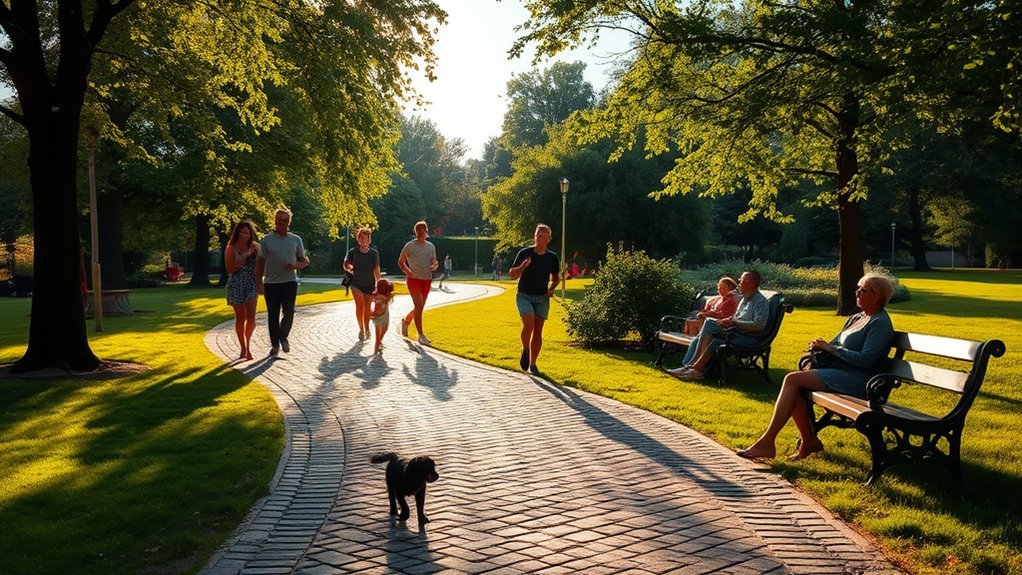A post-meal walk can be invigorating, yet it can also lead to discomfort if not done correctly. It’s essential to strike the right balance for ideal digestion and mood enhancement. Starting at a gentle pace and choosing the right environment can make all the difference. But what pitfalls should you avoid to guarantee your walk is both enjoyable and beneficial? Understanding the do’s and don’ts will set you on the path to a more pleasant experience.
Key Takeaways
- Do wait at least 30 minutes after eating to allow digestion to begin before starting your walk for a more pleasant experience.
- Do choose a scenic route to enhance mood and reduce stress, benefiting both mental health and digestion.
- Do start at a gentle pace and warm up with stretches to maximize the benefits of your post-meal walk.
- Don’t overexert yourself; maintain a moderate pace and listen to your body to avoid discomfort or fatigue.
- Don’t walk immediately after eating; it diverts blood flow from the digestive organs, hindering efficient digestion.
The Benefits of Taking a Post-Meal Walk
Taking a post-meal walk can greatly enhance your digestion and overall well-being. A brief stroll can provide a digestion boost by helping your body process food more efficiently, reducing bloating and discomfort. Research shows that light physical activity stimulates the digestive system, promoting quicker nutrient absorption.
Additionally, walking after meals offers mood enhancement benefits. It releases endorphins, those feel-good hormones, making you feel happier and more relaxed. This simple habit can be a natural stress reliever, helping you to unwind and clear your mind.
Incorporating a walk into your routine not only supports your digestive health but also elevates your mood, making it a win-win for both body and mind.
Do: Start With a Gentle Pace
Starting your post-meal walk at a gentle pace is essential for maximizing its benefits. This slow approach allows your body to ease into movement, promoting better digestion and reducing discomfort.
Begin with gentle stretches to warm up your muscles and prepare your body for walking. As you stroll, practice mindful breathing—inhale deeply through your nose and exhale through your mouth. This not only calms your mind but also enhances oxygen flow, helping you feel more energized.
Aim for a pace that feels comfortable, allowing you to enjoy the scenery and connect with your surroundings. By starting gently, you set the stage for a beneficial experience that supports both your physical and mental well-being.
Don’t: Walk Immediately After Eating
While it might be tempting to head out for a walk right after finishing your meal, doing so can lead to discomfort and hinder your digestion.
When you eat, your body directs blood flow to your digestive organs, kickstarting the digestion process. If you walk immediately after eating, you divert that blood away from your stomach and intestines, slowing down digestion and potentially causing cramps or bloating.
Timing matters when it comes to post-meal activities. It’s generally recommended to wait at least 30 minutes to an hour before taking a stroll. This brief pause allows your stomach to begin breaking down food efficiently, leading to a more pleasant walking experience and better overall digestion.
Do: Choose the Right Environment
Choosing the right environment for your post-meal walk can enhance your experience and improve your digestion. Opt for scenic routes that offer beautiful views, whether it’s a park, beach, or quiet neighborhood. The sights of nature can uplift your mood and encourage a more pleasant experience.
Additionally, walking in calming surroundings, like tree-lined paths or near water, helps reduce stress and promotes relaxation. Studies show that being in nature can lower cortisol levels, making your walk even more beneficial for digestion.
Don’t: Overexert Yourself
After you’ve selected a pleasant environment for your post-meal walk, it’s important to remember not to overexert yourself.
Overexertion risks can include fatigue, muscle soreness, or even digestive discomfort, which can ruin the benefits of your walk.
Stick to moderate walking techniques, such as maintaining a steady pace and focusing on deep breathing.
Focus on a steady pace and deep breathing to enhance your walking experience.
Listen to your body—if you feel tired or strained, slow down or take a break.
Aim for a walk lasting 10 to 30 minutes, depending on your fitness level and how you feel after eating.
This way, you can promote digestion and enhance your mood without pushing yourself too hard.
Enjoy your walk, and let it be a relaxing experience!
Frequently Asked Questions
Can Post-Meal Walks Help With Digestion?
Yes, post-meal walks can boost digestion benefits like a gentle breeze easing a storm. By varying your walking intensity, you encourage better digestion, helping your body process food more efficiently and feel lighter afterward.
How Long Should a Post-Meal Walk Last?
A post-meal walk should last around 10 to 20 minutes. Short walks during this ideal duration can enhance digestion and boost your mood, so grab those walking shoes and enjoy a rejuvenating stroll!
Is Walking Beneficial for Weight Loss?
Walking’s like a gentle breeze for your weight loss journey, igniting caloric burn and boosting metabolism. When you step outside, you’re not just moving; you’re actively transforming your body and enhancing your health.
Can Children Join in on Post-Meal Walks?
Children can join in on post-meal walks. It promotes children’s activity, encourages healthy habits, and strengthens family bonding. Plus, it’s a fun way to spend quality time together while staying active after meals.
What Should I Wear for a Post-Meal Walk?
For your post-meal walk, wear comfortable clothing that allows movement, like breathable fabrics. A good footwear choice, such as supportive sneakers, guarantees you stay light on your feet and enjoy the stroll without discomfort.
